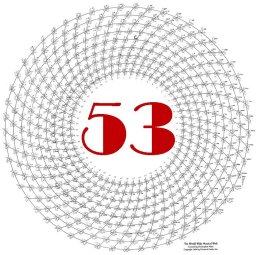Next Page: 14/6 – Septimal Chord Progressions
We talked briefly about the Diaschismic comma in Chapter 11. Let’s discuss it further here. As I said in Chapter 11, the 2048/2025 ratio of four perfect fifths plus two major thirds up is 19.5 cents flatter than the nearest octave. That’s covering a big swath of harmonic territory, and it is such a jolt away from the tonic that it tends to threaten or even dissolve the feeling of a tonal center—which is exactly why the 19th century Romantics and even some 18th century composers like Rameau and Bach loved it so much. Sometimes it is employed within a single key, but it is often used as a means of catapulting the music into a distantly related modulation. In 12-eq, a single note on the keyboard can represent the Diaschismic pair. In 53-eq, the Diaschismic comma of 19.5 cents is very closely approximated by a single step in 53-eq (22.64 cents). Here again what a Diaschisma looks like within C:
Figure 14-8 Diaschisma
. G1#
. |
.C – G – D — A — E
. |
A1b
The 19.5 cent gap between the A1b and the G1# can be used as one of the biggest harmonic leaps you can take in 12-eq. The Diaschisma can be used to blur the distinction between the dominant seventh and the augmented sixth (bVI#6) chords, the best-known of which are Italian, German and French Augmented Sixth chords. In 53-eq, the German bVI chord in C would be A1b, C, E1b, F1#. In 12-eq, that same chord would by necessity sound like an Ab dominant seventh chord: Ab-C-Eb-F# (same as Gb). I chose to talk about the diashisma alongside the seventh chords because they sound identical or similar in 12-eq but function very differently in 53-equal. Once again, the comma that is hidden in 12-eq is now exposed as two separate pitches in 53-eq. And the augmented sixth chords sound much less dissonant than do dominant seventh chords in 53-eq. Allaudin Mathieu has an excellent analysis of the Diaschisma in Chapter 32 of his book, Harmonic Experience. In 53-eq, you can hear that the augmented sixth chords have a beautiful, lush richness to them. They also function differently. The dominant seventh is pulled towards the tonic. The German Sixth pulls you in a completely different direction!
Figure 14-9: VI chords; Dominant 7th Pythagorean vs German bVI (see notes above). The first musical example before, played on a piano sampler, starts with the harmonic path of the Diaschisma. The second example plays only the chords notated below, with wind instrument samples.
If you would like to learn more about this chapter, “Diaschisma,” you can buy the entire book, The Grand Unified Theory of Music, in pdf form for $25 with hundreds of embedded musical examples of scales and chords from all over the world.
A free introduction to what The Grand Unified Theory of Music offers is on this website and includes both text and a few musical examples from each webpage. If you would like to learn more about this chapter and the full contents of this entire e-book, you can buy The Grand Unified Theory of Music for $25, with hundreds of embedded musical examples of scales and chords from all over the world — and ideas for how to set up your computer system —
HERE.
You’ll get a personalized password you can use to see the entire e-book. Inside the full book, you will also get a link to the complete pdf file of this e-book, which you can read on your Kindle or similar device. The links to the hundreds of mp3 sound files – the same ones you can hear on the website — will also be included. This is “Version 1.0” of The Grand Unified Theory of Music. Because it is an e-book, additions, corrections and improvements in the sound may be added at any time. The Grand Unified Theory of Music is Copyright © 2018 by Christopher Mohr. All rights reserved.
One person per password. Sharing this password with others is a violation of copyright. Do not allow others to use your password or link to the pdf file!

